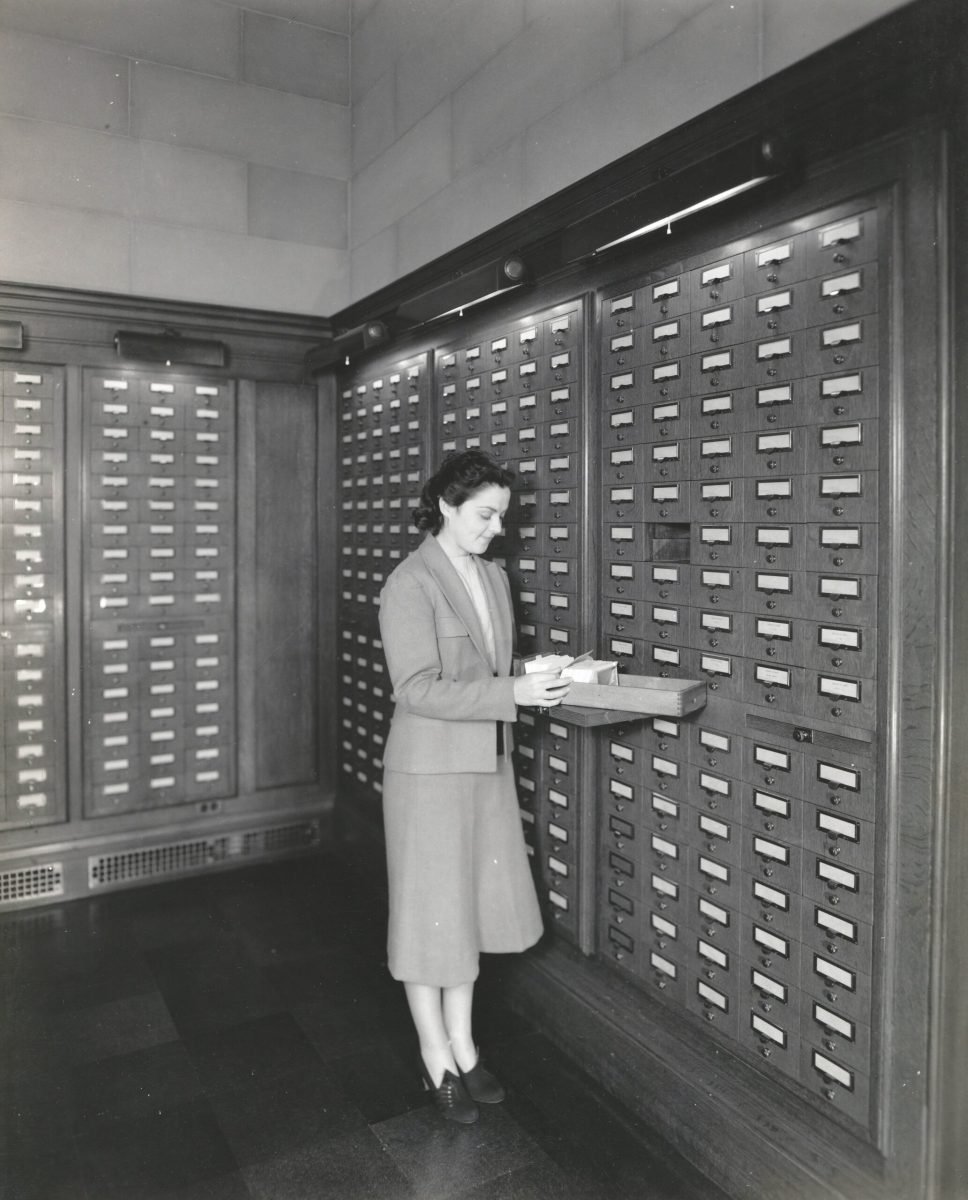We’re celebrating American Archives Month by looking back on the history of the National Archives.

If you have ever researched at the National Archives you are familiar with the concept of a record group. Within the National Archives, a record group is basically a collection of records that belong to the government entity that created or maintained them. These are usually an agency (e.g., U.S. Department of the Interior) or bureau (e.g., Bureau of Indian Affairs) or in the case of Congress, the House or Senate.
When the National Archives first began taking in records from federal agencies in the 1930s, staff weren’t exactly sure how to best organize them. Initially, the agency cataloged records by accession and included all accessions in the Archivist’s Third Annual Report. In 1940, the National Archives produced its first guide using this same format.

But this type of organization and description wasn’t really all that helpful for researchers. So, on March 1, 1940, first Archivist of the United States R.D.W. Connor issued a memorandum establishing a special committee, the Advisory Committee on Finding Mediums, to study the adequacy of the agency’s finding aids.
According to Connor, the purpose of the committee was to create “finding mediums and other instruments for facilitating the use of records,” which he broadly defined as “(1) Recommendations on transfer; (2) identification inventories; (3) preliminary reports; (4) identification of series reports; (5) historical summaries; (6) classification schemes; (7) catalogs and indexes; (8) catalog surveys; (9) inventories and lists; (10) calendars; (11) special reports; and (12) guides.”

Even though he did not expressly request that the committee study the overall organization of the National Archives’ holdings, nonetheless the committee did, and what it came up with paved the way for the current organization of National Archives’ records: the record group.
The committee included Marcus Price, Assistant Director of Archival Service; Solon Buck, Director of Publications; Philip Hamer, Chief of the Division of Reference; Dallas Irvine, Chief of the Division of War Department Archives; and W.L.G. Joerg, Chief of the Division of Maps and Charts.
The committee worked quickly and thoroughly. Between March 4 and May 22, 1940, it held 14 meetings and reviewed dozens of reports from chiefs of professional divisions, National Archives staff, and interested outside parties. It also heard oral statements from witnesses.
Early on, one of its members, Solon Buck, stated that the agency needed to organize its holdings in some sort of archival grouping before they could make any sort of preliminary reports. After much discussion and debate, the idea of organizing by record group took hold.


On January 15, 1941, the committee filed its report with the Director of Archival Service, who transmitted it with his comments to the Archivist on February 14. Of all the recommendations, Section 4, establishing the concept of a record group, has had the biggest impact on the agency:
“Section 4. That cataloging by accessions shall be discontinued and there shall be substituted therefor cataloging by record groups. The term ‘record group’ is defined as a major archival unit established somewhat arbitrarily with due regard to the principle of provenance and to the desirability of making the unit of convenient size and character for the work of arrangement and description and for the publication of inventories.”
Section 5 of the report directed the Division of Research and Records Description to proceed with tentative identifications and registrations of record groups. The division’s director, Oliver Wendell Holmes, took on the task of registering the record groups. These registrations were intended to serve as an administrative control over, and as a general guide to, the National Archives’ holdings.

The first step for Holmes was to make a tentative list of record groups. At the time, though, staff didn’t fully agree on what exactly should constitute a record group, and decisions were often arbitrary. The only real consensus was that the numbering of the record groups would be in the order of which the records were accessioned, and the records would remain in the original order in which they were received. Due to staff shortage caused by World War II, it wasn’t until June 30, 1944, that Holmes announced the 190 tentative record groups (206 record groups were actually created).
Because just about every government entity is organized differently, it was nearly impossible to have a standard organization for all the records being created. So, in general, the National Archives established record groups, then series within each record group, that reflected the organization of the agency that created the records. That is pretty much where similarities between record groups’ organization ends.
Six years after the adoption of record groups, the National Archives produced a staff information paper titled The Control of Records at the Record Group Level. When explaining the creation of record groups, it says:
It should be understood that no one of these principles is necessarily conclusive and that some are even contradictory of others. All should be considered in relation to the provenance, completeness, quantity, relationship to other records, and other qualities and characteristics of the records on which action is to be taken, and the decision should be made in any particular instance on good judgment as to what will most conveniently serve the purposes both of the National Archives and of those persons who are expected to seek information from the records in its custody.

Today, the highest record group number in the National Archives is RG 614, Records of the Office of Pandemic Preparedness and Response Policy. But this doesn’t mean we have 614 record groups. There are some unassigned numbers for records that once were their own record group but have since been incorporated into other record groups.
While it may not be perfect, the National Archives’ use of record groups has survived for over 80 years. You can see a list of all our current record groups on our website.
Read Oliver Wendell Holmes’s oral history interview, where he discusses the Advisory Committee on Finding Mediums and the creation of record groups.





